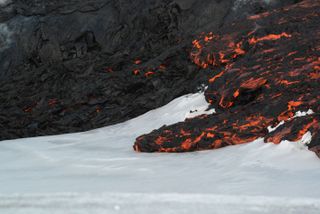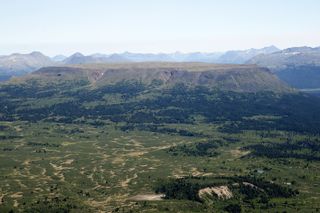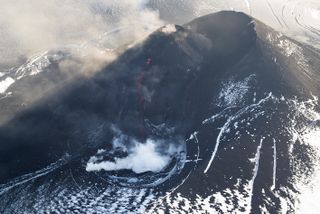
Volcanoes Guard Ice Age Secrets

Standing eye level with oncoming lava, in a snow pit he is digging at Tolbachik volcano in Russia, Ben Edwards is hoping his world doesn't violently explode in the next few minutes.
Several years of watching lava trundle over ice and snow has taught Edwards, a volcanologist at Dickinson College in Pennsylvania, that he's probably safe — at this spot, the volcano's incandescent rock rarely sparked the kind of blasts typically seen when lava meets water.
Finished with the snow pit, Edwards clambers out and waits for water to start trickling out of the deep walls. "There was no obvious meltwater at Tolbachik, so we think the water drains immediately from the [lava-snow] interface, down under the snow," Edwards said.
Understanding how snow-capped volcanoes generate meltwater will help scientists better predict flooding from so-called glaciovolcanic eruptions, a significant hazard. Among the worst natural disasters are massive floods from icy urban volcanoes such as Washington's Mount Rainer. In Iceland in 1996, a sudden flood called a jökulhlaup destroyed part of the national highway after Grímsvötn volcano melted its overlying glacier.
But for Edwards, working at the extremes of fire and ice means more than predicting future hazards. He is also among a handful of geoscientists pioneering a new way to make sense of past ice ages — with volcanoes that erupted through ancient ice sheets.
"These are volcanoes with unique features that we can use to understand what's happened to Earth's climate over the last 10 to 15 million years," Edwards told Live Science's Our Amazing Planet. [Fire and Ice: Images of Volcano-Ice Encounters]

When fire meets ice
Sign up for the Live Science daily newsletter now
Get the world’s most fascinating discoveries delivered straight to your inbox.
Most of Earth's climate history comes from the ocean floor, from chemical signatures preserved in mud and microscopic sea creatures. Drilling into the seafloor rewards researchers with cores holding millions of years of natural temperature swings. (Even during an ice age, Earth's temperature shifts back and forth a little bit.) But matching these mucky cores to glacial advances and retreats on land is complicated by the glaciers themselves.
Like giant erasers, glaciers scour away much of their record of past movement as they shrink and grow. In North America, only the last few glacial cycles can be found by geologic detectives. And the rubbly piles left behind may be impossible to pin down with an accurate age, which is key to matching glacial history to ocean climate records.
Enter the weird volcanoes called tuyas.
Tuyas are like little pushpins marking where and when ice covered the land. Though each tuya volcano may have erupted thousands of years apart, reconstructing their history is yielding new insight into the advance and retreat of continental ice sheets.
"They act as tide marks of vanished ice, and this information doesn't exist in any other form," said Dave McGarvie, a volcanologist at the Open University in Scotland.
Picture a volcano that looks like a towering bakery cake, with steep sides and a flat top. To those with a trained eye, the bottom layers obviously formed underwater. The rocks are bulbous pillow lavas and exploded lava glass, called hyaloclastite. But the frosting on top is a normal-looking lava flow, like those that cool in air.
In the 1940s, a Canadian geologist first figured out how this strange stack of rocks appeared. The flat-topped volcano, called Tuya Butte, erupted underneath a long-gone ice sheet that once covered much of British Columbia. First, the volcanic heat thawed the ice, producing the bottom layers, called pillow lavas. As the ice thinned and a small meltwater lake formed, the overlying pressure lessened, and the lava had room to explode.
"One bit of basalt can melt about 10 to 14 times its own volume of ice, so you get a lot of water appearing very, very quickly during an eruption," McGarvie said.
The confining ice kept everything piled up into a steep-sided hill. When the volcano was tall enough to burst through the ice sheet, the lava could cool in the air, creating the flat top. (If enough lava pours out, the volcano will build a traditional cone shape on top.)
"Imagine this amazing-looking island sitting in this moat of water surrounded by an ice wall," McGarvie said. "When it all melts away, you're left with a flat-top mountain."

Frozen in time
The beauty of tuyas is that their hard rock preserves the height of the ice sheet, even though glaciers may grind away at the volcano. The transition from the waterline to aerial lavas is like the ring left on the inside of a bathtub. And tiny minerals in the lavas provide a precise age. [Image Gallery: Wild Volcanoes]
"Every time a volcano erupts it gives you a photograph of the ice," said John Smellie, a volcanologist at the University of Leicester in the United Kingdom.
In western Canada, where scores of volcanoes erupted in the past millennia, geoscientists are quilting together the past thickness of the North American ice sheet with lava, and linking it to ocean cores. For example, ocean cores are often correlated by changes in oxygen isotopes (atoms with different numbers of neutrons) in ocean sediments. Edwards can now point to a volcano in British Columbia and say the ice on land was at least 300 meters [985 feet] thick during a certain marine isotope stage that corresponds to a cold Earth.
"With these volcanoes we have 2 million years of records," Edwards said. "We have some volcanoes that erupted 10 to 15 times. It's not continuous, but we can start to think about whether the ice was always the same thickness," he said.
"This is important for people doing big-scale climate models, because there's really not much of a check on their models for ice sheets growing and disappearing. These kind of studies provide points that modelers can use, and they darn well better have ice that's a kilometer thick in B.C. volcanoes," Edwards said.
In Iceland, where tuyas are called table mountains, glacier-volcano records can also provide a chronology of the ice sheets immediately south of the Arctic Circle, McGarvie said. More than half of Iceland's glaciers lie nearby or flow directly over volcanoes today.
McGarvie is also scaling volcanoes in Chile to estimate the past thickness of tropical ice and link it to the marine climate record. Part of the Patagonian ice field, the glaciers were once more extensive and scientists think their expansion and contraction provides a sensitive record of past climate change.

The original G-V
And in Antarctica, home to most of Earth's glaciovolcanoes, past eruptions have resolved one of the thorniest ice sheet debates in recent decades, Smellie said.
"For 30 years people have argued for when the East Antarctic Ice Sheet made the transition from a relatively warm and movable ice sheet to its relatively cold and stable state," Smellie told Live Science's Our Amazing Planet.
Why does this matter? An ice sheet with a warm bottom can respond more quickly to a warming climate, meaning East Antarctica's massive glaciers might soon shift into fast-flowing mode, rapidly raising sea levels.
Smellie and his colleagues looked at the ice sheet's past history during warmer and colder climate swings by examining volcanic rocks in Victoria Land, which includes a large segment of the Transantarctic Mountains, the range the separates East and West Antarctica. [Images: The Majestic Transantarctic Mountains]
"There are a lot of unique features about volcanoes that erupt under ice sheets, and we can determine how warm [the base of] that ice sheet was," Smellie said.
They discovered that neither side was right. East Antarctica wasn't exclusively warm or cold in the past 12 million years. Instead, the base of the ice sheet was a patchwork throughout its history. The findings were published in January 2014 in the journal Geology.
"[East Antarctica] is not liable to collapse if the world increases in temperature by 3 degrees Celsius," (or 5.4 degrees Fahrenheit), Smellie said.

Growing interest
While glaciovolcanism is attracting growing interest from scientists, its experts say there is much work to be done in exploring and explaining volcano-ice interactions.
At Tolbachik, Edwards was studying a modern volcano to better interpret the strange shapes that formed when Canada's volcanoes erupted beneath glaciers.
Lava freezes into amazing patterns when it flows on, under and next to ice and snow, and modern eruptions offer clues to how these patterns form. "Most of my career is trying to do forensic studies, so it is very, very instructive to actually watch the lavas go into the ice and watch the textures form," Edwards said.
"I think we're on the cusp of a big burst of people starting to really take apart these old volcanoes," Edwards added. "There are a lot of places where no one has looked at these deposits."
Smellie hopes the burgeoning field will someday provide better constraints on climate models.
"One thing, which is kind of the holy grail for me, is that people have quite logically linked the waxing and waning of ice sheets to global sea levels, but no one has got any handle on the actual volumes of ice that are melting at any one time," he said. "My hope is that glaciovolcanism will give us much more rigorous and realistic thicknesses for ice in past times," Smellie said.
Email Becky Oskin or follow her @beckyoskin. Follow us @OAPlanet, Facebook and Google+. Original article at Live Science's Our Amazing Planet.

Most Popular


